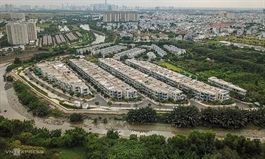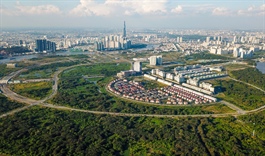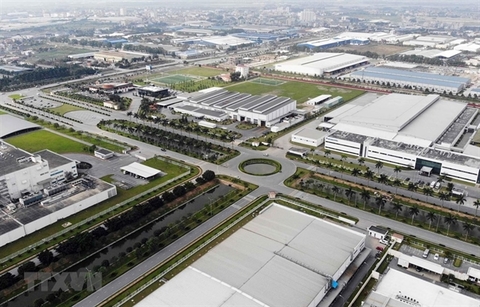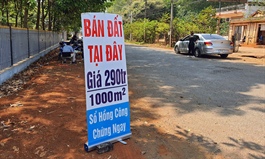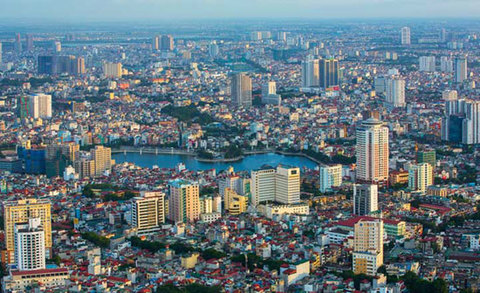Medley of factors spur property-buying spree
Medley of factors spur property-buying spree
The real estate frenzy across the nation has pushed land prices to record heights, while lenders are taking a vigilant approach. However, tightening real estate loans may not be the magic bullet to rein in buyers.

Commercial banks are more equipped than ever to deal with bubbles that occur in the real estate market, photo Le Toan
|
In this first quarter, land price rises were experienced across various provinces and cities, in the range of 30-50 per cent. Cities and provinces neighbouring Hanoi and Ho Chi Minh City have witnessed a significant increase, usually up to as much as 50 per cent.
“Low interest rates, an improving domestic economy, the rising popularity of urban lifestyle, and glittering appeal of industrial property as well as potential infrastructure projects have significantly spurred property buying across the nation in the past few years,” explained State Bank of Vietnam’s (SBV) Deputy Governor Dao Minh Tu.
The price hikes from north to south have attracted large amounts of cash flow. As of mid-March, real estate credit increased by 2.13 per cent, higher than the banking sector’s credit growth rate of the whole system (2.04 per cent). However, the SBV noted that real estate credit increased tremendously at a limited number of banks.
Both foreign-invested and local lenders are also trimming their interest rates to cash in on the increasing mortgage demand, illustrated in the cases of Shinhan Bank, UOB, and Standard Chartered. For instance, UOB reduced its rates from 8.7 to 6.49 per cent annually, while Shinhan Bank cut its annual rates from 6.7 to 6.3 per cent.
Some market watchdogs believed that, in the short term, the economic downturn has pushed investment capital flows out of manufacturing, tourism, and services sectors, which could find their way to the real estate industry. In the long run, real estate will be consistently placed high on the investment portfolio of individual and institutional investors, as its glitter of offering physical shelter and value stand the test of time.
Deputy Governor Tu of the SBV noted that the central bank has kept a firm hand on capital flows into the real estate sector due to their risky nature. Accordingly, credit pouring into the real estate sector has been gradually reduced during the last three years, especially in 2020 due to the pandemic. This ratio had grown by 11.89 per cent, compared to 26 and 28 per cent in 2018 and 2019, respectively.
In the first three months of this year, credit had grown by 3 per cent against the end of 2020, nearly equal to the normal ratio of 2.93 per cent in general.
“The figures show that the SBV is keeping a tight grip on the real estate loans, especially the flow into the high-end and hospitality segment,” Tu said.
Specifically, the central bank has set limits and safety ratios in banking operations to gradually reduce the ratio of short-term capital reserved for medium- and long-term loans and apply higher risk ratios for the loans of high value house buyers, aiming to direct credit flows into medium- and low-cost and social housing which are in major need of the end-users.
On the same note, commercial lenders are also taking a cautious approach to the real estate sector.
According to Nguyen Dinh Tung, general director of OCB Bank, when granting credit quotas to lenders, the SBV also guides the orientation of pouring capital into five priority areas. The portfolio of loans for securities and real estate, which are considered as risky sectors, has been strictly curbed accordingly.
Nguyen Hoang Linh, general director of MSB, said that by the end of the first quarter of 2021, the bank’s real estate loan proportion was only about 11 per cent of its total outstanding loans, much lower than 21 per cent in 2019.
Nguyen Thanh Do, vice chairman of HDBank’s board, stated that the real estate loans account for around 19 per cent of the total outstanding loans of the whole economy.
“Commercial banks are now becoming well-equipped to make it through the real estate bubble. Besides the SBV’s tightening regulations in this regard, each lender should implement its own legal corridor to set a loan ceiling ratio in this risky sector, which is in line with its financial health,” Do suggested.
Notwithstanding, the credit on the real estate market is not the main reason for the land price hike, and the stricter tightening of real estate credit cannot halt the increasing price, cited the SBV.
Even credit has increased slightly again, and not signalled any abnormal signs. Amid the turmoil of the real estate market in 2011-2012, credit for the real estate sector accounted for 40 per cent of the total outstanding loans of the whole system.
“Real estate-linked credit is not a major foundation for the land price hike. Real estate-related firms are hunting for more cash through various channels, such as corporate bonds, remittances, foreign direct investment, and mergers and acquisitions,” said Deputy Governor Tu.
Nguyen Tu Anh, general director of the Department of Economics Affairs at the Party Central Committee’s Economic Commission noted, “The main reason for the land price hike stems from the announcement of future plans for infrastructure, industrial parks, and new construction. Thus, tightening real estate credit would not be the magic pill to stop the feverish excitement in land.”





